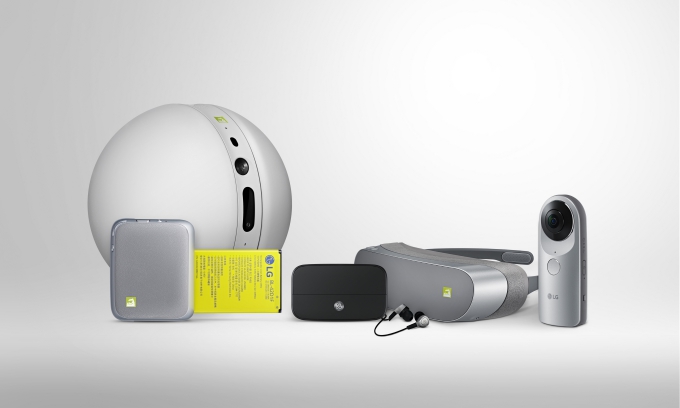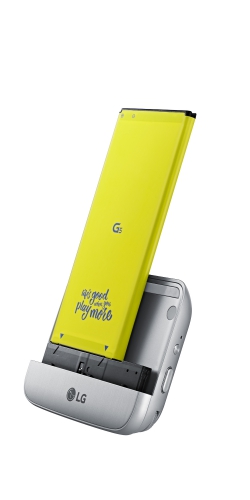
Yesterday, on the eve of the first official day of Mobile World Congress 2016, LG’s President Juno Cho took to the stage to unveil the company’s latest flagship Android smartphone, the LG G5. As is customary in this age of media, much of the G5’s more interesting features were already known before the event. It’s aluminum design was not a surprise, nor was the always on screen, nor the slick mechanism that allows users to remove the battery. Yet, despite knowing what was about to be revealed, watching LG push forward the idea of modular smartphone design in Barcelona was still wondrous.
Modular smartphones have been pondered in the past, usually the result of news that a monolithic tech company had begun R&D work on the concept, but the idea never crept into the commercial smartphone market in any significant way. LG changed that yesterday when it officially announced the LG Cam Plus and LG Hi-Fi Plus, two modules that replace the G5’s standard bottom chin with extra functionality for photography and audio playback, respectively.
It’s an interesting move for the South Korean electronics company, but LG has always been nothing if not interesting. It’s most recent smartphone, the V10, came equipped with dual-screens and two front-facing cameras, one standard and one wide angle (a feature that returns on the G5, this time in the rear cameras), two things no other phone included. LG should be given credit for continually pushing the boundaries of what smartphones can be, but it is often lost in the shuffle among larger players like Apple and Samsung. Its lower profile is also a blessing, though, allowing the company the freedom to be inventive, the freedom to release a flagship device with a modular lean.  The choice, most likely, will not be remembered as a seismic shift in smartphone design but, as Vlad Savov put it for The Verge, it is radical. It’s not a modular design in the same vein as Phonebloks, the idea that took the internet by storm in September 2013, but it is a new way of thinking about the flagship smartphone. Imagine if Apple unveiled a modular iPhone. The world might literally burn itself to the ground. But, the Cupertino company is known for its careful, meticulous design evolution, not taking a risky chance on a new, weird idea. LG, if the slate of accessories (or, “friends,” seen above) it also unveiled yesterday prove anything, is that company. And thank the Universe it is.
The choice, most likely, will not be remembered as a seismic shift in smartphone design but, as Vlad Savov put it for The Verge, it is radical. It’s not a modular design in the same vein as Phonebloks, the idea that took the internet by storm in September 2013, but it is a new way of thinking about the flagship smartphone. Imagine if Apple unveiled a modular iPhone. The world might literally burn itself to the ground. But, the Cupertino company is known for its careful, meticulous design evolution, not taking a risky chance on a new, weird idea. LG, if the slate of accessories (or, “friends,” seen above) it also unveiled yesterday prove anything, is that company. And thank the Universe it is.
The conversation around technology as a whole the last year or so has been the lack of true innovation, the smartphone market in particular has become a staid sector that sees marginal improvements year over year but hasn’t had a revolutionary product for some time. Two months into 2016, and it already looks like this year could be huge for smartphone advancement.
The Nextbit Robin is rethinking how smartphone storage works, and now LG is rethinking what your smartphone can be. But the grandiose ideas don’t matter if the implementation is poor, so how does the G5’s fancy new contraption work? On the lower left hand side of the device you’ll find a small button. When pressed, the bottom chin, battery attached, is released, allowing users to swap it out for a different module.
 Unfortunately, we are not in Barcelona to get our hands on the phone, but reports are that it works as advertised and feels supremely well built. The bigger question for me is whether more modules, from LG or third parties, are on the way and how useful they will be. The two unveiled yesterday failed to grasp my imagination, though I could see the LG Cam Plus appealing to more people than the Hi-Fi Plus. Still, the act of taking a photo with a smartphone is not particularly difficult that you need an attachment that offers a physical shutter button, video button and jog dial for controlling zoom.
Unfortunately, we are not in Barcelona to get our hands on the phone, but reports are that it works as advertised and feels supremely well built. The bigger question for me is whether more modules, from LG or third parties, are on the way and how useful they will be. The two unveiled yesterday failed to grasp my imagination, though I could see the LG Cam Plus appealing to more people than the Hi-Fi Plus. Still, the act of taking a photo with a smartphone is not particularly difficult that you need an attachment that offers a physical shutter button, video button and jog dial for controlling zoom.
The Hi-Fi Plus strikes me as an even more niche product. It was made in conjunction with highly respected audio electronics maker Bang & Olufsen and turns the G5 into a 32-bit DAC and amplifier to give users higher quality audio playback. It’s a nice idea, but my gut says that the majority of consumers will be excited that LG found a way to keep a removable battery with the new aluminum construction, and won’t care so much about the modules.
Nonetheless, LG should be lauded for pushing the entire industry in a new direction. It’s hard to say whether others will follow, but the smartphone market was in desperate need of new blood. Years from now, it is absolutely possible we’ll view yesterday’s announcement as the time LG swung big for modular smartphones and missed. Right now, that doesn’t matter. The important thing is that LG did swing, and potentially reshaped the definition of the flagship smartphone.